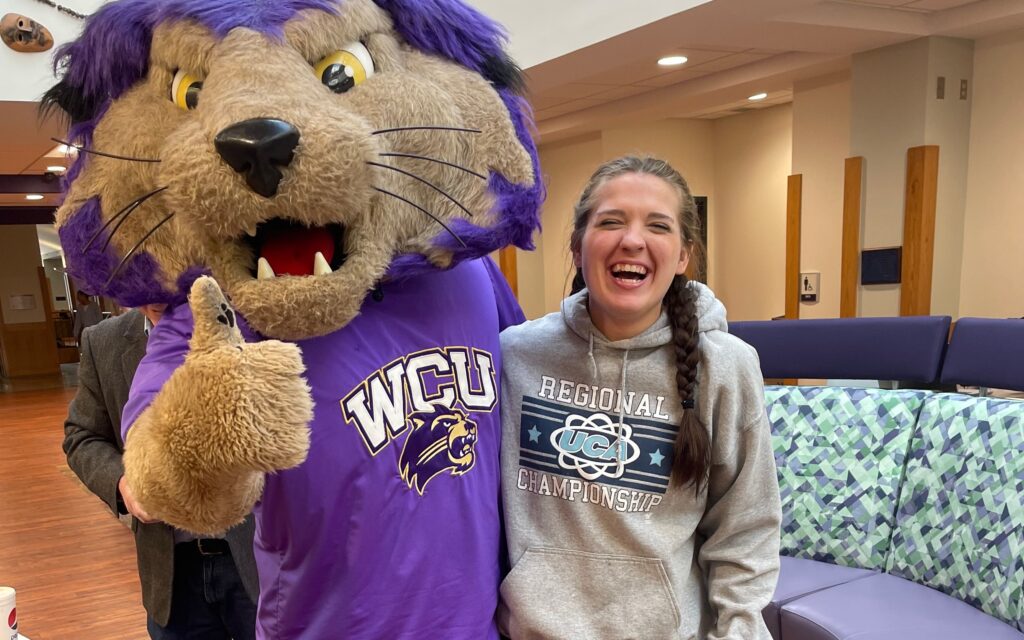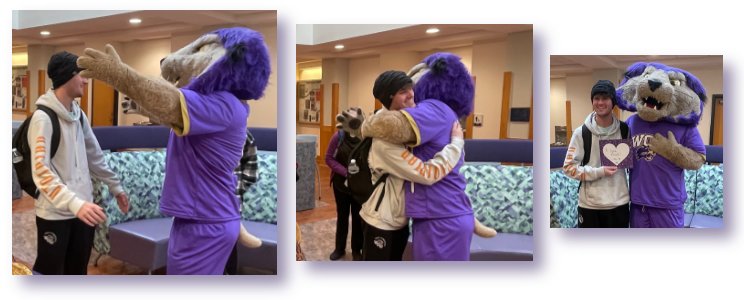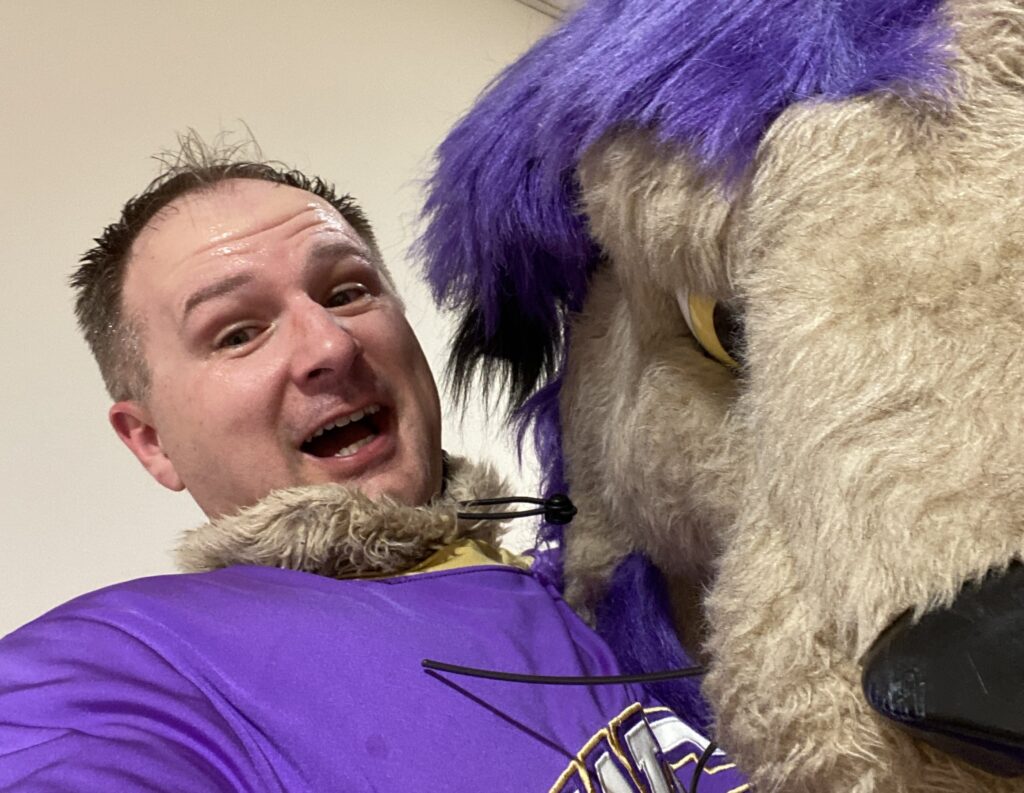
The joys and exhaustion of becoming a college mascot
Tuesday we hosted an event on campus to kick-off our month-long “I Love WCU” celebration. We set up a couple of tables at the university center, we hand out cookies, we generate good will. It’s a fun event, and the most worthwhile part is hearing from students about the things they love most about their alma mater.
The unexpectedly fun part, though, came after the fellow who normally plays Paws, the WCU mascot, called in sick. Rebekah, one of my colleagues, called to let me know. Back in November, Rebekah portrayed the mascot herself in a commercial we produced for Giving Tuesday, but she suggested this time I should don the suit instead. I was wary at first, and later I would find out why she was happy to pawn this off on me, but eventually I agreed. The athletics staff delivered the mascot costume, and I jumped in.
Well…jumped isn’t exactly the right word. You have to carefully strap into the get-up. It took probably ten or fifteen minutes to get it all assembled–not that it’s that difficult, but mostly that the more implements you put on, the fewer fine motor skills you have left. It’s a bit like a band uniform–overall bottoms, covered by a pull-over top (padded, muscular, not English-major-ish at all) that are directly connected to the cat’s hands. You strap on humorously large sandals that are its feet, and you pull on an oversized head connected to a football helmet. Once you’re in, you’re in. There’s no quick exit.
There’s an opening in the cat’s mouth about the size of an iPhone that lets you see out–but even that is covered by black, mesh fabric. The interior carries the lingering smell of a sweaty locker room. When fully assembled, the costume renders you into a human baked potato. I was sweating before I finished getting dressed.
Alone in the changing area, my performance ahead of me, I paused to get into the right mental space. I have to confess that my general personality–40-something father of three, not college kid–isn’t naturally suited for playing a mascot. I closed my eyes, took a final breath of clean, cool, unadulterated, fresh air, and pulled the cat head on.
Then, I walked out.

Mascots are often played by different people, and it wasn’t until this week that I began to really understand how the individual character of a mascot stretches across dozens of performers spanning decades. Several different people have become Paws this year alone, for instance, but I’ve always considered him a singular person.
Perhaps that’s because a mascot’s character is broad enough that it isn’t too hard for multiple people to portray it. In general, there’s only one hard and fast rule to playing a mascot: you can’t speak. Paws has to point or act in an animated fashion to convey an idea. Beyond that one rule, though, there isn’t much else to playing a mascot. The inspiration for the character comes naturally; you’re strapped inside a giant, furry cat costume. You are a walking cartoon with an enormous head, and before long you simply begin to manifest cartoonish motions in your walk, your gestures, and your reactions.
It took a few minutes to figure out how to walk–which sounds odd, but then again, my feet were four times their usual size–and then how to affect a certain bounce or swagger befitting of a gigantic catamount. The tiny, fabric-covered window through which you can see eliminates any peripheral field of vision. It’s tough to hear out of or discern which direction sound is coming from.
The students in the university center reacted on sight–not surprising when you picture a person in a seven foot-tall furry costume loitering near Einstein Bros. Bagels, but something I wasn’t at all used to in my normal life. Remember, I’m an administrator. I blend in better than the plants. Students never pay attention to me when I go to the bagel shop. Now, I was a celebrity.
I quickly learned that mascots have enormous social latitude. You can approach random strangers, and they are forced to react. You can interrupt conversations, even though you are non-verbal. You can accost the kid wearing an App State hoodie. You can demand someone high-fives you. (Mind you, it’s a totally blind high-five. You put your arm up and trust the other person with a full field of vision will be able to see and slap it.)
Students would call out “Hey, Paws!” from across the university center lawn. They would approach and ask for a selfie. They would ask me questions, even though I couldn’t answer. One student asked if I remembered taking a picture with her at the basketball game last week. I nodded enthusiastically. Mascots cannot lie.
(A quick note about the selfies. After my fourth or fifth picture, it struck me that I was smiling like an idiot underneath the enormous cat head–but nobody could see my actual face. Later, I realized the best way for Paws to show up in a photo was for me to tilt the head slightly down. So whenever someone took a selfie with me, I was standing there, chin down, unsmiling, sweating like an English major taking a calculus exam, and nobody knew the difference.)
A group of students with Down syndrome who are part of our University Participant program approached me. One was so thoroughly excited to meet Paws that she jumped up and down and gave me a long, tight hug. It was the best part of my day.
The act requires perpetual motion, which takes a physical toll. There isn’t any down time. The mascot can’t sit around scrolling on a cell phone or take a nap in the sun. Every step had to be jaunty. Every motion had to be exaggerated. Every non-verbal reaction had to be 100 percent.
After about forty-five minutes, I sensed that I had sweated through all of my clothes. My heartrate reached full cardio cruising altitude. One of my coworkers graciously found me a bottle of water, and I snuck off to a hiding spot to pull off the head and rehydrate. (Another rule, I guess: the mascot cannot be seen partially assembled. You put on or take off the costume away from everyone else. You don’t take the head off while you’re standing in the middle of a crowd. The mascot simply appears, and then he simply disappears. If you have to take care of something, you do it in private.)
My hat is off to anyone who can pull off the command performance of a mascot for the length of an entire football game, not to mention the hours of tailgating beforehand, not to mention in the heat of a late summer or early fall day. Not to mention in a place that, unlike the mountains of North Carolina, suffers hellish heat and humidity throughout football season. I can only imagine that such places use mascot uniforms with built-in intravenous Gatorade machines.
I was in costume for only about an hour and a half, and that was long enough for me. I took the elevator back up to my out-of-the-way changing spot and delivered myself from the fur-oven, folding the pieces and putting them back into their unassuming travel bags.
On my way out, I couldn’t help still walking bowlegged (the best way I can describe the logistics of walking with oversized cat feet), and it was difficult to avoid swinging my arms and bouncing. The fast juxtaposition of becoming just another grown-up wearing khakis in a sea of college kids was remarkable. Nobody glanced twice in my direction. Nobody called out my name. Nobody high-fived. Nobody asked for a selfie, because that would have been very, very weird.
Over the years, we’ve brought our kiddos up to Western for football games, and there are lots of photos on my phone taken with Paws and our children. It’s funny to look at those now, knowing that behind the maniacally grinning furry face was a person, someone whose name I will probably never know, grimacing under a football helmet and dripping in sweat, all just to make our day.







Leave a Reply